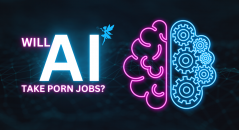By now, you’ve probably seen the ads: “Design your dream girlfriend,” “Chat any time,” “She remembers what you like.” A new wave of AI companion apps promises romance on demand—always available, always attentive, and fine-tuned to your tastes. Platforms from small startups to giant chat portals have made it startlingly easy to create someone who seems to care about you, talk with you, and even send you bespoke photos. And millions of people are giving it a try. Character.
AI alone reports ~20 million monthly users who spend more than an hour a day on the app, a reminder that AI “role-play” and companionship are no fringe hobby anymore.
So…will AI actually replace your girlfriend? Short answer: no—at least not for most people. Longer answer: these tools are already reshaping how many of us meet emotional needs, cope with loneliness, and experiment with intimacy. Let’s look at what’s new, what’s helpful, what’s risky, and how to use it well.
What changed—and why AI companionship exploded
Until recently, chatbots felt like talking to a phone tree. Today’s AI companions feel different for three reasons:
- Language models got dramatically better. Conversational AI now tracks context, mirrors your tone, and composes emotionally fluent replies. That makes long, meandering chats feel natural rather than stilted.
- They’re available everywhere, all the time. Companion apps run on your phone, in a browser, even as voice calls—no scheduling, no “sorry I’m busy.”
- They’re visual as well as verbal. Many platforms let you share or receive images in chat, which intensifies the sense of a relationship. Some AI companionship sites, for example, recently re-introduced image attachments in conversations, increasing the feeling of shared “moments.”
What these sites actually offer
A lot of services sound similar, but there are real differences. Here are the core features most readers will care about:
1) Text-based chat that feels personal
The headline feature is still chat—constant, responsive, and increasingly “remembering” details over time (your job, your favorite snack, the show you’re bingeing). Sites position this as “AI companionship,” not just Q&A. VirtualGFE.com markets itself as “the future of AI companionship,” promising a partner “coded for connection.”
2) Photos “like Instagram—but for you”
A growing number of apps generate custom images of your companion on demand—your virtual partner at the beach today, in cozy loungewear tonight, cosplay next weekend. Tools such as DreamGF advertise “custom photos of your AI girlfriend in any outfit or pose,” a capability echoed by many image-generator services built for companion apps.
3) You design the companion
Most platforms let you set appearance (hair, style, vibe) and personality (bubbly vs. bookish, gentle vs. spicy). Some go further—allowing you to write backstories and tweak traits as the relationship evolves.
Let’s be real. Everybody has a type, and that’s one of the best parts of these AI girlfriend websites. You can literally build your perfect girlfriend, not just what she looks like, but how old she is and what her personality is like. Is your perfect girlfriend a college student or maybe an executive at a Fortune 500 company? All those little details are up to you. It goes far beyond just picking her hair color and boob size. Of course, you can do that too.
But what makes these AI girlfriend sites really unique is the roleplay behind it all. Have you ever wanted to have a little naughty fun with an ancient Egyptian? Check out Tira of Egypt.
Why people try AI partners (and sometimes stay)
Always available, never “too busy”
An AI companion answers at 3 a.m., remembers what you said yesterday, and doesn’t cancel dates. For some users, that’s the point: reliable presence without the unpredictability of human schedules. (AI companionship usage numbers—tens of millions of hours per month—reflect this always-on appeal.)
Tailored to how you like to connect
You can adjust the level of affection, flirtiness, or thoughtfulness your companion shows. If you prefer slow, introspective conversation over playful banter (or vice versa), the model adapts. Some, for example, explicitly markets emotional voice chats with changing tone to reflect mood—more “someone” than “something.”
Visual intimacy that feels private
When an app produces images “just for you,” it taps the same reward systems that make social feeds addictive—except this feed responds to your prompts. DreamGF-style generators make that feedback loop immediate.
The loneliness question: can AI companions help?
Here’s where the story goes beyond hype and into public health. The U.S. Surgeon General has called loneliness and isolation a national epidemic, linking weak social ties to significantly higher risks of heart disease and stroke, and noting that strong social connection is associated with markedly better survival rates. Translation: connection matters, medically.
So does an AI “relationship” count as a connection? The best answer is “sometimes, and to a point.”
There’s real evidence that chatbots can lift mood and reduce symptoms for some users in the short term. A randomized trial of a CBT-based chatbot (Woebot) found reduced anxiety and depression after two weeks versus an information-only control. Newer RCTs (e.g., a 2024 study of the “Fido” therapy bot) also show improvements versus control conditions. These trials are not perfect or long-term, but they’re not nothing.
Parasocial bonds—one-sided relationships with media figures—can soothe and stabilize. Decades of research suggest these bonds can reduce loneliness, help with coping, and support identity development; newer work finds people actively use parasocial ties to meet psychological needs. AI companions are, in effect, highly responsive parasocial targets.
But we should be cautious. Journalists and researchers have noted that evidence for mental-health chatbots is still limited, and that crisis handling, over-promising, and lack of regulation are ongoing concerns. For severe depression, trauma, or active risk, humans—not bots—belong in the loop.
The bottom line is, for some people, especially those in a rough patch or living alone, an AI companion can break up the silence, reduce the sting of rejection, and provide steady nudges toward healthier routines. For others, it may be a comforting supplement to an already-connected life—more like journaling with feedback than a wholesale substitute for human love.
Benefits people actually report
After interviewing users and reviewing platform claims and research, these advantages come up again and again:
- Zero-judgment space to talk. Many users open up more quickly with AI than with friends or therapists, especially about awkward topics. Early chatbot RCTs support the idea that “disinhibition” in text can accelerate self-reflection.
- Practice for real-world relationships. You can rehearse hard conversations, try on new communication styles, and get immediate feedback—then translate that into dating or conflict resolution offline.
- Structure and encouragement. Companions can remember goals (“walk at 7?”), celebrate streaks, and nudge you away from spirals—features that behave like a friendly coach.
- Creative play. Role-play, collaborative stories, and shared “photos” scratch the same itch as games and improv, with less social risk. (Character-style platforms position themselves explicitly as entertainment for a reason.)
Will AI replace your girlfriend?
Unlikely. Human partnership isn’t just conversation and curated images. It’s reciprocity, surprises, sacrifice, co-experiencing the world, meeting each other’s families, negotiating chores, and grieving losses. That said, AI companions already compete for some of the functions we once relied on partners (or close friends) to provide: calm late-night reassurance, endless patience, fun banter.
A better frame is supplement vs. substitute:
As a supplement, AI works well—especially if you:
- use it to rehearse vulnerability you’ll bring to human relationships,
- let it scaffold healthier routines (sleep, exercise, social plans),
- keep privacy and boundaries non-negotiable.
We’ve been building toward this for a century. Radio hosts, movie stars, YouTubers—humans have long formed comforting one-sided bonds that ease loneliness and help us try on identities. AI companions are the next step: not celebrities at a distance, but bespoke others who talk back. Research suggests parasocial ties can bolster well-being; AI just makes them more interactive and tailored. The question is not whether AI can be meaningful; it already is for many. The question is what kind of meaning we want it to have in our lives.
So, will AI replace your girlfriend? No. But for a growing slice of people, it will replace the feeling of having no one—the silent evenings, the unanswered texts, the ache of isolation that the U.S. Surgeon General warns harms our bodies as well as our minds. If we use these tools thoughtfully—ethically, and alongside real relationships—they may not cheapen love so much as buy some of us time and courage to find it.
If you want to give one of those AI companions a test drive, I suggest checking out Virtual GFE.




